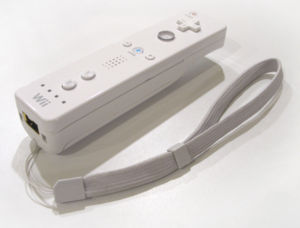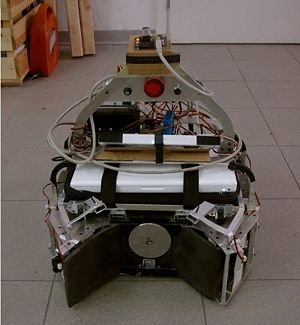Difference between revisions of "ROBOWII"
| Line 1: | Line 1: | ||
=== General description === | === General description === | ||
| − | |||
<br> | <br> | ||
| Line 12: | Line 11: | ||
Antonio Bianchi and Ben Chen developed a game system (Robowii) where the human player has to try to point a led target on the robot with the infrared camera of the WIIMote, while the robot tries to get a target position and at the same time to avoid to be caught. | Antonio Bianchi and Ben Chen developed a game system (Robowii) where the human player has to try to point a led target on the robot with the infrared camera of the WIIMote, while the robot tries to get a target position and at the same time to avoid to be caught. | ||
<br/> | <br/> | ||
| + | |||
| + | [[Image:Wiimote.jpg|thumb|left|Wii Remote controller]] | ||
[[Image:Robowii_robot.jpg|thumb|right|300px|The first robot]] | [[Image:Robowii_robot.jpg|thumb|right|300px|The first robot]] | ||
| Line 59: | Line 60: | ||
Some documentation about game design ([[Media: GameDesign.zip]]). If anybody finds anything else and finds it interesting, please send it to Andrea Bonarini. | Some documentation about game design ([[Media: GameDesign.zip]]). If anybody finds anything else and finds it interesting, please send it to Andrea Bonarini. | ||
| − | + | ----- | |
=== Robowii Video === | === Robowii Video === | ||
Revision as of 11:29, 24 February 2009
Contents
General description
Aim of this project is to develop games where people interact with autonomous robots by using the WII Remote, the main controller of the Nintendo WII console.Since Wii Remote (shortly: Wiimote) has onboard a 3-axis accelerometer, and infrared camera, a speaker, 4 leds, a vibration system and many buttons, it could be used as a human-computer interface in many robotic applications.
RoboWII 1.0
Antonio Bianchi and Ben Chen developed a game system (Robowii) where the human player has to try to point a led target on the robot with the infrared camera of the WIIMote, while the robot tries to get a target position and at the same time to avoid to be caught.
They have used a robot originally used in Robocup, with a two-wheels differential kinematics.
RoboWII has been developed in Linux, using C++. The communication between computer and WIIMote is done using the library Wiiuse. Moreover, some packages developed at Politecnico di Milano within the MRT project (Modular Robotic Toolkit) have been used:
- DCDT, for message exchange among the components of RoboWII
- Mr. Brian, to program fuzzy logic behaviors
The localization software was originally developed within the LURCH project, and is able to localize the robot w.r.t. a set of printed markers placed on the ceiling over the playground. This software uses the ArtToolkitPlus libraries.
Available Doumentation
- Bachelor thesis by Bianchi e Chen: Media:Tesina_robowii.pdf
- Code:Media: robowii_v1.1.tgz
- Last version (Media: robowii_v1.2.tgz) compatible with Ubuntu 8.10. Contains detailed instructions for intallation on Ubuntu 8.10
- Guide to MRT software
Material
Nella scatola del progetto si trova:
- 1 Nintendo Wiimote
- angolari di metallo, velcro e cartone (per il montaggio della sensor bar e della telecamera)
- il materiale usato precedentemente per il progetto Polyphemus (telecamera mobile, cavi vari, ...)
Sul robot è presente:
- 1 telecamera Firewire
- 1 cavo firewire (3 mt.)
- 1 Airboard
Utente sul Mac Mini (user: robowii, password: robowii)
WhereWiiAre
Botta and Bottinelli developed for their bachelor thesis a marker-based self-localization system using the WIIMote
Available Doumentation
- Bachelor thesis by Botta e Bottinelli with data and tests on the Wiimote Media:TesinaWhereWiiAre.pdf
RoboWII 2.0
Antonio Micali is developing a second, improved version on a new robot, Spyke
Some documentation about game design (Media: GameDesign.zip). If anybody finds anything else and finds it interesting, please send it to Andrea Bonarini.
Robowii Video
People
Advisor: Andrea Bonarini
Work done
- Project start: March 2008
- First prototype delivered (Bachelor thesis Bianchi&Chen - September 2008)
- New robot arrival (Spyke) (Antonio Micali - November 2008)
- New interface to control the new robot from a remote PC (Antonio Micali - December 2008)
Planning
- Installation of sonar belt (Antonio Micali - March 2009)
- Estension of the existing game considering the sonar belt (Antonio Micali - April 2009)
- Design and implementation of a new game with game design methodology (Andrea Pontecorvo - 2009)
- Design new robot ed implementation (Ben Chen - 2009)
Laboratory work and risk analysis
Laboratory work for this project is mainly performed at AIRLab/Lambrate. It includes some mechanical work and electrical and electronic activity. Potentially risky activities are the following:
- Use of mechanical tools. Standard safety measures described in Safety norms will be followed.
- Use of soldering iron. Standard safety measures described in Safety norms will be followed.
- Transportation of heavy loads (e.g. robots). Standard safety measures described in Safety norms will be followed.
- Robot testing. Standard safety measures described in Safety norms will be followed.

